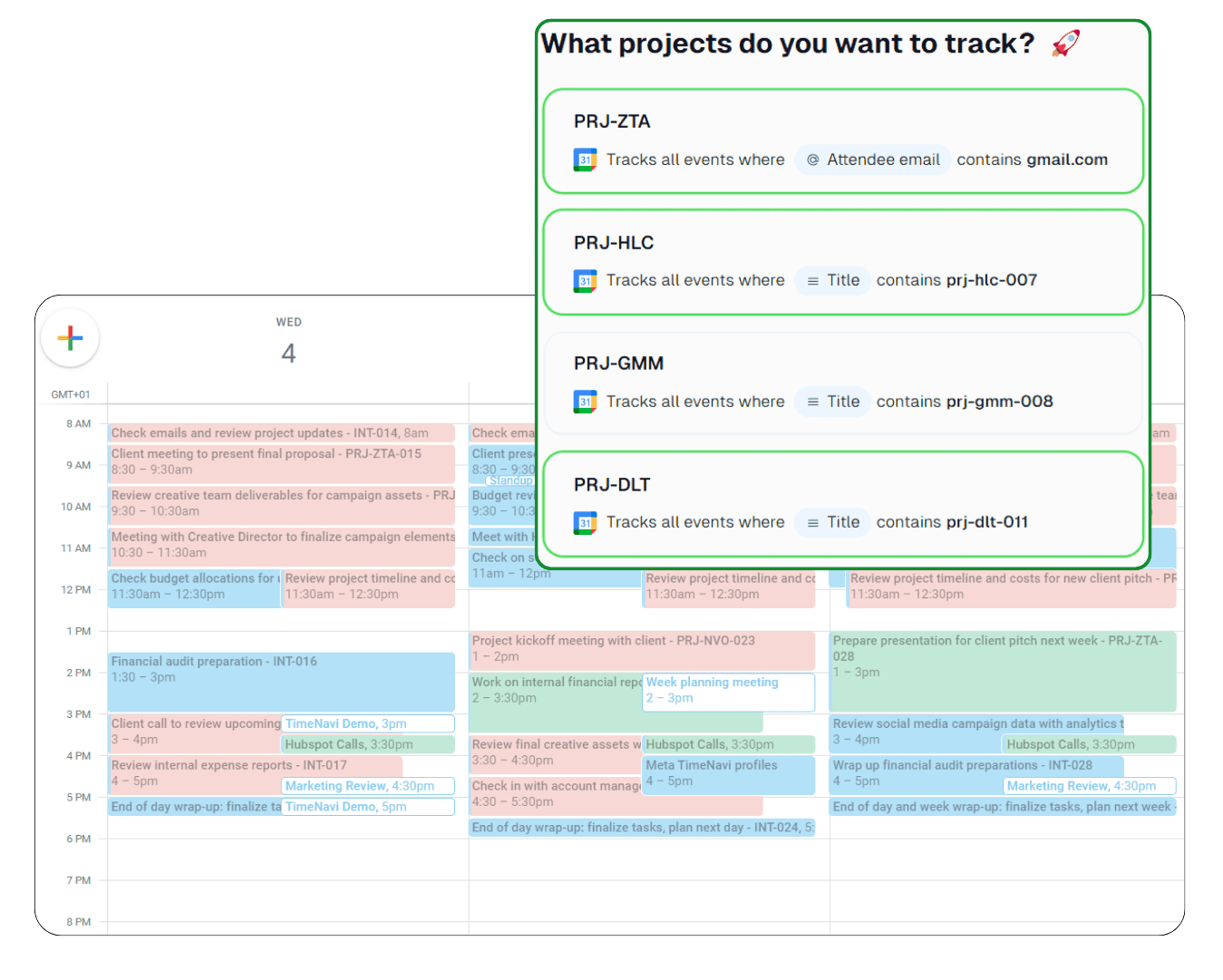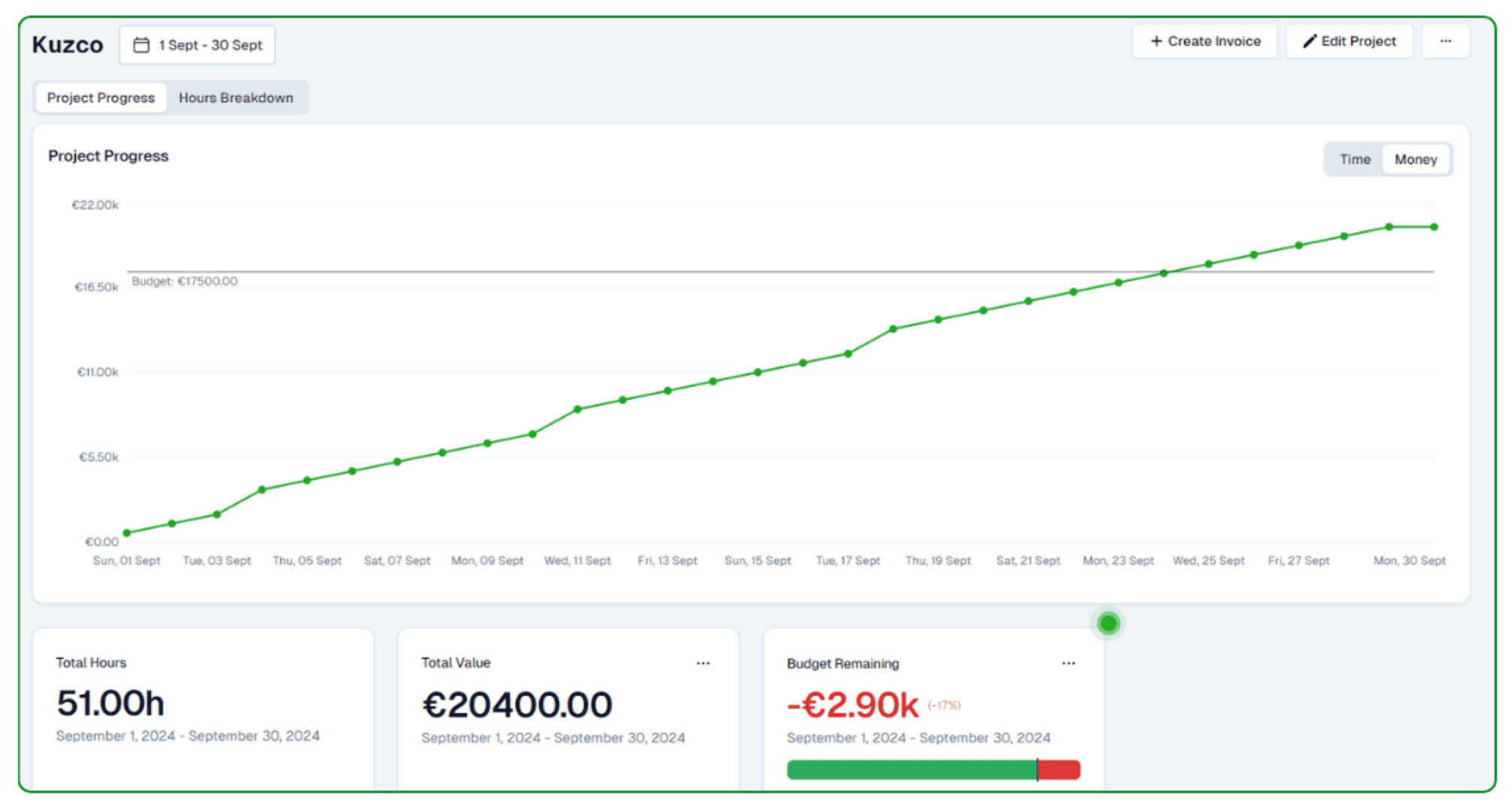When you’re lost for time
Stop me if this sounds familiar: your team is working around the clock, projects are being delivered - yet somehow, it only came together at the last minute. You’re stretching time and money. There’s no respite before the next project is already behind schedule nor is there a comfortable profit margin.
Over the course of the project, the workload pushes against your target deadline as meetings pile up, improvements come to light and tasks drag on longer than expected - you’re left wishing for more time but the budget won’t allow it. Most often, effective time management is the key for successful project delivery because the problem isn’t the standard of work but your handle on team time. Therefore, investing in a time management tool for your team will unlock the hidden potential of your business by boosting productivity and alleviating the stress of imminent deadlines.
Common Time Drains in Agencies:
In this article we’ll outline 5 places where time is often sunk to no end. Better time management which will help your agency to sustain the momentum of rolling projects without hitting burn-out or scraping profits.
Non-billable hours don’t have a price-tag: By this, I don’t mean that internal meetings, creative exploration or project management are a waste of time. Instead, it’s easy to burn through internal hours like free money because team time is not fairly valued nor prioritized.
Overloaded Meetings: Long, drawn-out meetings are a massive time sink. If meetings consistently run over, cover unnecessary topics or are not properly coordinated so that the right people turn up, then they're a distraction from billable time.
Laborious Admin Work: Tasks like updating project management software, responding to internal emails, or chasing client approvals can eat up significant time, yet they’re rarely included in project estimates. Management software should streamline these tasks, not add to the workload. When admin work goes untracked, it becomes an invisible drain on productivity.
Circular client feedback: In the creative industry, going the extra mile is often expected. However, endless rounds of client feedback stretch internal resources, dragging projects on and sapping profitability. Agencies must prioritize their team's time and manage client expectations, ensuring feedback doesn’t derail project timelines.
Unrealistic project estimates: As your agency gains traction in the industry and experience with a variety of projects, this gives you a pretty good idea on your estimated costs for a project and how much to bill your client - although every project is different and not perfectly predictable. Nonetheless, if you want to bootstrap your finances, then an educated guess won’t suffice. Automated time-tracking tools like TimeNavi provide concrete data on where time is spent, allowing for more accurate billing and resource allocation.
Over time, poor time management will result in reduced profitability, higher operating costs, and even cash flow problems at the end of the month. Agencies might even find themselves hiring freelancers to handle the overflow, further driving up costs without a clear return on investment.
Why Traditional Time Tracking Isn’t Enough
If you’re relying on traditional time tracking methods—manual entry or project management tools—you might think you have a handle on where time is going. But traditional systems often fall short in fast-paced agency environments and disrupt the workflow. Here’s why:
Untracked Time: Employees juggling multiple projects or rushing to meet deadlines often forget to log time, especially for small tasks like client revisions or internal emails. Without an incentive, tracking often gets neglected, leading to lost hours.
Focus on Billable Work Only: Most agencies track only billable hours, overlooking the significant amount of time spent on non-billable tasks, like internal meetings or project management. This gives an incomplete picture of where time is actually going.
Tracking Takes Time: Manually logging hours or updating project management systems can, ironically, become a time drain. Time spent tracking is time that could have been spent on productive work, and it often goes unbilled.
How Calendar Analytics Like TimeNavi Can Help
The good news? You don’t need to overhaul your entire workflow to fix these issues. Google Calendar analytics tools like TimeNavi offer a simple, automatic solution to track time without manual input.
Automatic Time Tracking. TimeNavi automatically converts events from your team’s Google Calendar into trackable data. No more forgetting to log hours—whether it’s billable client meetings or non-billable admin work, everything is captured seamlessly. TimeNavi is conveniently integrated with the Google Workspace, it is easy to onboard the team.

Clear Insights on Time and Profitability. With TimeNavi, you get a comprehensive view of how your team’s time is spent. Not only can you see where time is going, but you can also link it to project costs, allowing you to pinpoint which clients are profitable and which are draining your resources. This visibility makes it easy to decide whether to renegotiate contracts or potentially cut unprofitable clients.
Realistic Estimates and Improved Workflow Efficiency. By using TimeNavi’s data, you can create more accurate project timelines and forecasts. This means fewer surprises, more accurate billing, and better resource allocation, helping your team avoid overtime and burnout.

Take Control of Your Team’s Time with TimeNavi
It’s easy to lose track of how time is being spent, especially when your team is juggling multiple projects, client revisions, and internal work. But with TimeNavi’s Calendar analytics, you can stop losing valuable hours and start optimizing your workflow.
By automatically tracking time, visualizing project profitability, and improving your forecasting, TimeNavi helps you gain a clear view of where time is going and how to use it more effectively. Ready to take back control of your team’s time?
TimeNavi is integrated with both Google & Outlook Calendars.
When you’re lost for time
Stop me if this sounds familiar: your team is working around the clock, projects are being delivered - yet somehow, it only came together at the last minute. You’re stretching time and money. There’s no respite before the next project is already behind schedule nor is there a comfortable profit margin.
Over the course of the project, the workload pushes against your target deadline as meetings pile up, improvements come to light and tasks drag on longer than expected - you’re left wishing for more time but the budget won’t allow it. Most often, effective time management is the key for successful project delivery because the problem isn’t the standard of work but your handle on team time. Therefore, investing in a time management tool for your team will unlock the hidden potential of your business by boosting productivity and alleviating the stress of imminent deadlines.
Common Time Drains in Agencies:
In this article we’ll outline 5 places where time is often sunk to no end. Better time management which will help your agency to sustain the momentum of rolling projects without hitting burn-out or scraping profits.
Non-billable hours don’t have a price-tag: By this, I don’t mean that internal meetings, creative exploration or project management are a waste of time. Instead, it’s easy to burn through internal hours like free money because team time is not fairly valued nor prioritized.
Overloaded Meetings: Long, drawn-out meetings are a massive time sink. If meetings consistently run over, cover unnecessary topics or are not properly coordinated so that the right people turn up, then they're a distraction from billable time.
Laborious Admin Work: Tasks like updating project management software, responding to internal emails, or chasing client approvals can eat up significant time, yet they’re rarely included in project estimates. Management software should streamline these tasks, not add to the workload. When admin work goes untracked, it becomes an invisible drain on productivity.
Circular client feedback: In the creative industry, going the extra mile is often expected. However, endless rounds of client feedback stretch internal resources, dragging projects on and sapping profitability. Agencies must prioritize their team's time and manage client expectations, ensuring feedback doesn’t derail project timelines.
Unrealistic project estimates: As your agency gains traction in the industry and experience with a variety of projects, this gives you a pretty good idea on your estimated costs for a project and how much to bill your client - although every project is different and not perfectly predictable. Nonetheless, if you want to bootstrap your finances, then an educated guess won’t suffice. Automated time-tracking tools like TimeNavi provide concrete data on where time is spent, allowing for more accurate billing and resource allocation.
Over time, poor time management will result in reduced profitability, higher operating costs, and even cash flow problems at the end of the month. Agencies might even find themselves hiring freelancers to handle the overflow, further driving up costs without a clear return on investment.
Why Traditional Time Tracking Isn’t Enough
If you’re relying on traditional time tracking methods—manual entry or project management tools—you might think you have a handle on where time is going. But traditional systems often fall short in fast-paced agency environments and disrupt the workflow. Here’s why:
Untracked Time: Employees juggling multiple projects or rushing to meet deadlines often forget to log time, especially for small tasks like client revisions or internal emails. Without an incentive, tracking often gets neglected, leading to lost hours.
Focus on Billable Work Only: Most agencies track only billable hours, overlooking the significant amount of time spent on non-billable tasks, like internal meetings or project management. This gives an incomplete picture of where time is actually going.
Tracking Takes Time: Manually logging hours or updating project management systems can, ironically, become a time drain. Time spent tracking is time that could have been spent on productive work, and it often goes unbilled.
How Calendar Analytics Like TimeNavi Can Help
The good news? You don’t need to overhaul your entire workflow to fix these issues. Google Calendar analytics tools like TimeNavi offer a simple, automatic solution to track time without manual input.
Automatic Time Tracking. TimeNavi automatically converts events from your team’s Google Calendar into trackable data. No more forgetting to log hours—whether it’s billable client meetings or non-billable admin work, everything is captured seamlessly. TimeNavi is conveniently integrated with the Google Workspace, it is easy to onboard the team.

Clear Insights on Time and Profitability. With TimeNavi, you get a comprehensive view of how your team’s time is spent. Not only can you see where time is going, but you can also link it to project costs, allowing you to pinpoint which clients are profitable and which are draining your resources. This visibility makes it easy to decide whether to renegotiate contracts or potentially cut unprofitable clients.
Realistic Estimates and Improved Workflow Efficiency. By using TimeNavi’s data, you can create more accurate project timelines and forecasts. This means fewer surprises, more accurate billing, and better resource allocation, helping your team avoid overtime and burnout.

Take Control of Your Team’s Time with TimeNavi
It’s easy to lose track of how time is being spent, especially when your team is juggling multiple projects, client revisions, and internal work. But with TimeNavi’s Calendar analytics, you can stop losing valuable hours and start optimizing your workflow.
By automatically tracking time, visualizing project profitability, and improving your forecasting, TimeNavi helps you gain a clear view of where time is going and how to use it more effectively. Ready to take back control of your team’s time?
TimeNavi is integrated with both Google & Outlook Calendars.
When you’re lost for time
Stop me if this sounds familiar: your team is working around the clock, projects are being delivered - yet somehow, it only came together at the last minute. You’re stretching time and money. There’s no respite before the next project is already behind schedule nor is there a comfortable profit margin.
Over the course of the project, the workload pushes against your target deadline as meetings pile up, improvements come to light and tasks drag on longer than expected - you’re left wishing for more time but the budget won’t allow it. Most often, effective time management is the key for successful project delivery because the problem isn’t the standard of work but your handle on team time. Therefore, investing in a time management tool for your team will unlock the hidden potential of your business by boosting productivity and alleviating the stress of imminent deadlines.
Common Time Drains in Agencies:
In this article we’ll outline 5 places where time is often sunk to no end. Better time management which will help your agency to sustain the momentum of rolling projects without hitting burn-out or scraping profits.
Non-billable hours don’t have a price-tag: By this, I don’t mean that internal meetings, creative exploration or project management are a waste of time. Instead, it’s easy to burn through internal hours like free money because team time is not fairly valued nor prioritized.
Overloaded Meetings: Long, drawn-out meetings are a massive time sink. If meetings consistently run over, cover unnecessary topics or are not properly coordinated so that the right people turn up, then they're a distraction from billable time.
Laborious Admin Work: Tasks like updating project management software, responding to internal emails, or chasing client approvals can eat up significant time, yet they’re rarely included in project estimates. Management software should streamline these tasks, not add to the workload. When admin work goes untracked, it becomes an invisible drain on productivity.
Circular client feedback: In the creative industry, going the extra mile is often expected. However, endless rounds of client feedback stretch internal resources, dragging projects on and sapping profitability. Agencies must prioritize their team's time and manage client expectations, ensuring feedback doesn’t derail project timelines.
Unrealistic project estimates: As your agency gains traction in the industry and experience with a variety of projects, this gives you a pretty good idea on your estimated costs for a project and how much to bill your client - although every project is different and not perfectly predictable. Nonetheless, if you want to bootstrap your finances, then an educated guess won’t suffice. Automated time-tracking tools like TimeNavi provide concrete data on where time is spent, allowing for more accurate billing and resource allocation.
Over time, poor time management will result in reduced profitability, higher operating costs, and even cash flow problems at the end of the month. Agencies might even find themselves hiring freelancers to handle the overflow, further driving up costs without a clear return on investment.
Why Traditional Time Tracking Isn’t Enough
If you’re relying on traditional time tracking methods—manual entry or project management tools—you might think you have a handle on where time is going. But traditional systems often fall short in fast-paced agency environments and disrupt the workflow. Here’s why:
Untracked Time: Employees juggling multiple projects or rushing to meet deadlines often forget to log time, especially for small tasks like client revisions or internal emails. Without an incentive, tracking often gets neglected, leading to lost hours.
Focus on Billable Work Only: Most agencies track only billable hours, overlooking the significant amount of time spent on non-billable tasks, like internal meetings or project management. This gives an incomplete picture of where time is actually going.
Tracking Takes Time: Manually logging hours or updating project management systems can, ironically, become a time drain. Time spent tracking is time that could have been spent on productive work, and it often goes unbilled.
How Calendar Analytics Like TimeNavi Can Help
The good news? You don’t need to overhaul your entire workflow to fix these issues. Google Calendar analytics tools like TimeNavi offer a simple, automatic solution to track time without manual input.
Automatic Time Tracking. TimeNavi automatically converts events from your team’s Google Calendar into trackable data. No more forgetting to log hours—whether it’s billable client meetings or non-billable admin work, everything is captured seamlessly. TimeNavi is conveniently integrated with the Google Workspace, it is easy to onboard the team.

Clear Insights on Time and Profitability. With TimeNavi, you get a comprehensive view of how your team’s time is spent. Not only can you see where time is going, but you can also link it to project costs, allowing you to pinpoint which clients are profitable and which are draining your resources. This visibility makes it easy to decide whether to renegotiate contracts or potentially cut unprofitable clients.
Realistic Estimates and Improved Workflow Efficiency. By using TimeNavi’s data, you can create more accurate project timelines and forecasts. This means fewer surprises, more accurate billing, and better resource allocation, helping your team avoid overtime and burnout.

Take Control of Your Team’s Time with TimeNavi
It’s easy to lose track of how time is being spent, especially when your team is juggling multiple projects, client revisions, and internal work. But with TimeNavi’s Calendar analytics, you can stop losing valuable hours and start optimizing your workflow.
By automatically tracking time, visualizing project profitability, and improving your forecasting, TimeNavi helps you gain a clear view of where time is going and how to use it more effectively. Ready to take back control of your team’s time?
TimeNavi is integrated with both Google & Outlook Calendars.
When you’re lost for time
Stop me if this sounds familiar: your team is working around the clock, projects are being delivered - yet somehow, it only came together at the last minute. You’re stretching time and money. There’s no respite before the next project is already behind schedule nor is there a comfortable profit margin.
Over the course of the project, the workload pushes against your target deadline as meetings pile up, improvements come to light and tasks drag on longer than expected - you’re left wishing for more time but the budget won’t allow it. Most often, effective time management is the key for successful project delivery because the problem isn’t the standard of work but your handle on team time. Therefore, investing in a time management tool for your team will unlock the hidden potential of your business by boosting productivity and alleviating the stress of imminent deadlines.
Common Time Drains in Agencies:
In this article we’ll outline 5 places where time is often sunk to no end. Better time management which will help your agency to sustain the momentum of rolling projects without hitting burn-out or scraping profits.
Non-billable hours don’t have a price-tag: By this, I don’t mean that internal meetings, creative exploration or project management are a waste of time. Instead, it’s easy to burn through internal hours like free money because team time is not fairly valued nor prioritized.
Overloaded Meetings: Long, drawn-out meetings are a massive time sink. If meetings consistently run over, cover unnecessary topics or are not properly coordinated so that the right people turn up, then they're a distraction from billable time.
Laborious Admin Work: Tasks like updating project management software, responding to internal emails, or chasing client approvals can eat up significant time, yet they’re rarely included in project estimates. Management software should streamline these tasks, not add to the workload. When admin work goes untracked, it becomes an invisible drain on productivity.
Circular client feedback: In the creative industry, going the extra mile is often expected. However, endless rounds of client feedback stretch internal resources, dragging projects on and sapping profitability. Agencies must prioritize their team's time and manage client expectations, ensuring feedback doesn’t derail project timelines.
Unrealistic project estimates: As your agency gains traction in the industry and experience with a variety of projects, this gives you a pretty good idea on your estimated costs for a project and how much to bill your client - although every project is different and not perfectly predictable. Nonetheless, if you want to bootstrap your finances, then an educated guess won’t suffice. Automated time-tracking tools like TimeNavi provide concrete data on where time is spent, allowing for more accurate billing and resource allocation.
Over time, poor time management will result in reduced profitability, higher operating costs, and even cash flow problems at the end of the month. Agencies might even find themselves hiring freelancers to handle the overflow, further driving up costs without a clear return on investment.
Why Traditional Time Tracking Isn’t Enough
If you’re relying on traditional time tracking methods—manual entry or project management tools—you might think you have a handle on where time is going. But traditional systems often fall short in fast-paced agency environments and disrupt the workflow. Here’s why:
Untracked Time: Employees juggling multiple projects or rushing to meet deadlines often forget to log time, especially for small tasks like client revisions or internal emails. Without an incentive, tracking often gets neglected, leading to lost hours.
Focus on Billable Work Only: Most agencies track only billable hours, overlooking the significant amount of time spent on non-billable tasks, like internal meetings or project management. This gives an incomplete picture of where time is actually going.
Tracking Takes Time: Manually logging hours or updating project management systems can, ironically, become a time drain. Time spent tracking is time that could have been spent on productive work, and it often goes unbilled.
How Calendar Analytics Like TimeNavi Can Help
The good news? You don’t need to overhaul your entire workflow to fix these issues. Google Calendar analytics tools like TimeNavi offer a simple, automatic solution to track time without manual input.
Automatic Time Tracking. TimeNavi automatically converts events from your team’s Google Calendar into trackable data. No more forgetting to log hours—whether it’s billable client meetings or non-billable admin work, everything is captured seamlessly. TimeNavi is conveniently integrated with the Google Workspace, it is easy to onboard the team.

Clear Insights on Time and Profitability. With TimeNavi, you get a comprehensive view of how your team’s time is spent. Not only can you see where time is going, but you can also link it to project costs, allowing you to pinpoint which clients are profitable and which are draining your resources. This visibility makes it easy to decide whether to renegotiate contracts or potentially cut unprofitable clients.
Realistic Estimates and Improved Workflow Efficiency. By using TimeNavi’s data, you can create more accurate project timelines and forecasts. This means fewer surprises, more accurate billing, and better resource allocation, helping your team avoid overtime and burnout.

Take Control of Your Team’s Time with TimeNavi
It’s easy to lose track of how time is being spent, especially when your team is juggling multiple projects, client revisions, and internal work. But with TimeNavi’s Calendar analytics, you can stop losing valuable hours and start optimizing your workflow.
By automatically tracking time, visualizing project profitability, and improving your forecasting, TimeNavi helps you gain a clear view of where time is going and how to use it more effectively. Ready to take back control of your team’s time?
TimeNavi is integrated with both Google & Outlook Calendars.


